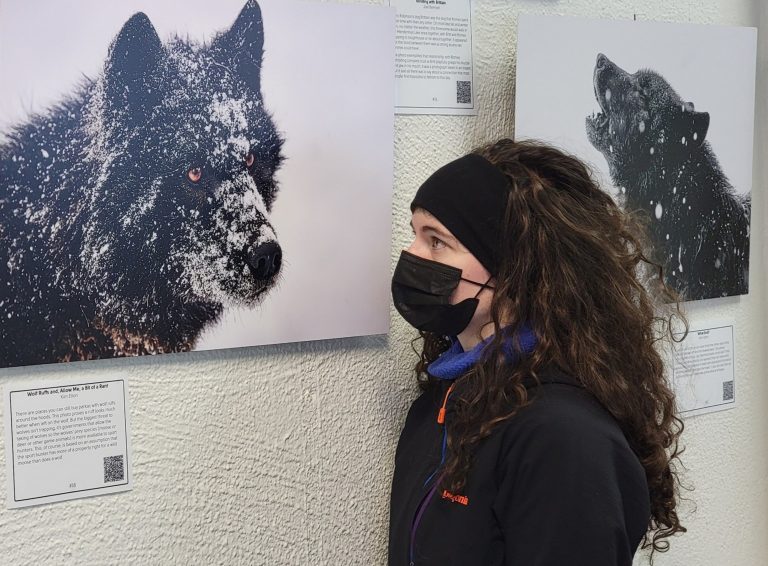Evie Walker eye to eye at the exhibit for the wolf Romeo. Courtesy Dr. Vic Walker.
There I stood, alone in a Florida motel room somewhere past midnight, staring into a laptop and talking to myself—voice thick in my throat as I rambled, spooling through a slide show. If a passer-by had peeped around the edge of the curtain, he might have been tempted to make some sort of intervention. But I wasn’t going around the bend, nor was I alone. There were hundreds of people watching and listening, scattered across the continent and beyond, many of them just as choked up. I could feel them out there, beyond the silence as I channeled my inner wolf.
Though trucks rumbled by on the interstate and pipes shook as someone upstairs turned on the shower, I was far away and 15 years back in time, standing on the ice of Mendenhall Lake cradled by snow-laden mountains, listening as a black wolf howled in the dusk; watching as he loped over to the Big Rock to play with dogs as a dozen people gathered—some leaning on ski poles, others lifting cameras as he neared; or dozing with him in the sun on a warming April day. Some of the folks who’d tuned into my Fireside Chat presentation that February night—virtual, of course, courtesy of the pandemic—had seen and heard that wolf themselves, had known him as I had, and thought of him as neighbor, even friend.
So, there he was: a wild black wolf, washed up like a castaway on our strange shore. He first appeared in summer of 2003 along the network of trails in the Mendenhall Glacier Recreation Area, on the outskirts of Juneau, Alaska. Perhaps he was an orphan, lone survivor of a decimated pack; or a young dispersing adult in search of a mate and his own territory. At first, little more than shadow and rumor, he gradually became more visible as ice formed on the lake. He took to following hikers and skiers with dogs, sometimes approaching to within a few feet, making overtures and keening a high-pitched whine. If both canines and humans were willing, some form of social interchange took place, anything from a polite pee-mail swap to an all-out, whirling play session, with a distinct lupine accent. And with our newly built home overlooking his favored ground on the west side of the lake, Sherrie and I not only held ringside seats for much of the unfolding drama; we and our dogs found ourselves near its epicenter.
The old phrase, a wolf at the door, suddenly held a literal meaning. Sometimes we saw fresh wolf prints just a stone’s toss from our drive; and often he lay waiting, curled on the ice beyond Skaters Cabin. Late at night I’d wake to his echoing howls, sometimes so close he seemed inside. With the lake as our extended back yard, naturally there were close encounters. The handsome stranger took a definite shine to our cream-colored Lab, Dakotah, a spayed female—seeking her out, begging to flirt and play. Meanwhile, he continued to meet and greet dogs, often dozens a day. Sherrie called him Romeo, and the name stuck.

Days, then weeks passed. Instead of slipping back into the mountains as we’d expected, Romeo became ever more familiar, seeming to lay claim to a territory that overlapped Juneau’s most popular recreation area, not to mention adjoining yards. While some locals watched his point-blank interactions in rapt fascination, others freaked. A hundred-plus-pound wolf, so close to kids and pets? Wolves and civilization just didn’t mix, they grumbled, and a few threatened to take matters into their own hands. Never mind that despite all the stories, wolves posed less statistical threat to public safety than meteorites; and besides, this was no ordinary wolf.
Of course, we worried, aware of the extreme danger he faced, so near to so many of our kind. We and others banged ski poles together, waved and yelled, hurled chunks of ice. State biologists tried to haze him away. And though he’d retreat, a day or two later there he was, awaiting his surrogate pack. Still, he seemed intent on learning and following our rules of engagement and was better mannered than some of the dogs and people he encountered.
No surprise that Romeo forged close bonds with certain dogs, relationships that defined friendship. But in the process, he also spent time around their humans, recognized them and in some cases seemed to form similar attachments, radiating sociable body language, expressions, and behavior that went far beyond mere tolerance. He wasn’t being fed or petted; had no apparent motive to make such positive gestures to a certain few people other than simply liking them. Why not? The interspecies bond between canines and humans is among the most remarkable on the planet.
For six years Romeo came and went, oblivious to our wrangles. Though controversy surrounding him continued to swirl and ebb, he’d become a fixture out by the glacier. He’d appear in autumn and stay through the spring thaw, then shift into the glacier-draped high country. Sometimes he’d disappear for weeks, and we’d wonder if he’d finally found a mate, or had at last met his end. In at least his eighth year, perhaps his ninth, he’d already more than doubled the life expectancy of a wild Alaskan wolf. Each time I watched him go, it was as if for the last time.

And then it was. The wolf we called Romeo vanished in September 2009. Pretty to imagine him lounging with his own fat pups on a sunny hillside; but instead, he was illegally shot by a pair of serial poachers and skinned for a trophy. In their boasts—which is how they eventually got caught—the killers flaunted a stunningly banal, small-minded evil. A high-profile trial was followed by a wrist slap; actual punishment amounted to a bad traffic ticket. After that, they ceased to matter.
We held a memorial service out by the Big Rock, and that could have been that. Memories fade, time passes, and people forget. Instead, a dozen years later, there’s a Romeo exhibit at the Mendenhall Glacier Visitor Center and a bronze plaque near Nugget Falls. Several books, two streets, a beer or two, and a local brand of coffee mark his time among us. I and many others have told his story to uncounted thousands of people; one online clickbait slide show, unauthorized but welcome, has garnered over 16 million views.
And this past February, there I stood making that presentation, part of a series of related events celebrating his life. This latest Romeo surge was set in motion by Juneau composer Todd Hunt and sponsored by the Orpheus Project, a southeast Alaska arts organization. Todd had read my book, and that had inspired him and fellow composer Emerson Eads to create and perform live separate works of “Wolf Songs”—a two-hour performance integrating avant-garde symphonic composition, operatic song, image projection, and dance. A Romeo photo exhibit also was created and displayed at the community arts center, and a cross-country ski event held in his old stomping grounds.
So it is that a lone black wolf came to live among us, became woven into Juneau’s story, part of who we are. Scarcely a day passes that he doesn’t cross my mind. His eyes follow me from wall-hung portraits and images on my laptop, and a bronze cast of his pawprint rests where I brush my hand across it as I pass. Those tangible objects remind me that I did more than dream; I once knew that wolf, as he certainly knew me. But this is what matters: Years from now, parents will tell their children, once upon a time, there was a wolf we called Romeo. And they’ll remember.


Comments are closed.